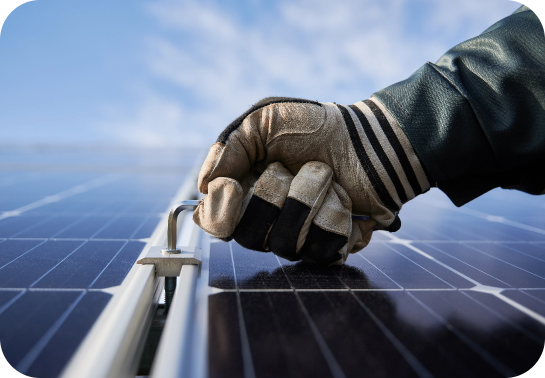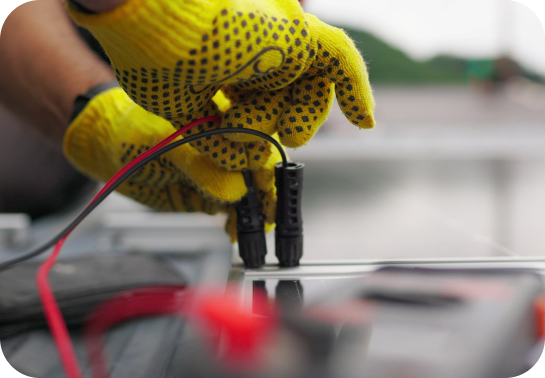Complete Guide to Solar Panel Maintenance: What to Know

Many people are turning to solar panels because of their cost-saving benefits. However, solar maintenance is something many homeowners overlook. If you invest in solar, your system will need regular maintenance to ensure optimal performance. In this guide, we’ll discuss everything you need to know about solar panel maintenance, from how to monitor your system and perform inspections to costs associated with solar panel services. Let’s get started!
Do Solar Panels Require Maintenance?
Yes, solar panels need routine maintenance, although they generally operate without disruption for long periods of time. Solar panels are designed to be durable and require minimal upkeep but regular solar maintenance is essential to maximize their efficiency.
If you find yourself wondering if your panels are working properly, the first step is to check their performance and then explore your cleaning and maintenance options.


How to Monitor Your Panels’ Health
It’s important to regularly monitor your system’s health to quickly address potential issues before they become significant problems. As a homeowner with a solar system you will typically be equipped with some kind of solar production monitoring software. By monitoring your panels, you can detect problems early on, ensure efficient energy production, and take necessary actions to extend their lifespan.
If it appears there is a problem with your solar panel production and the cause is not obvious, such as coverage by snow or debris then you may need professional support to test the components of your system for issues.
How to Maintain Solar Panels
Proper solar maintenance requires regular cleaning, inspections, and addressing repairs. Periodically cleaning your panels to remove dirt and debris helps them operate efficiently. Conducting inspections helps identify signs of damage or issues that need repairs. Quickly addressing repairs, such as fixing loose wires or replacing faulty components, ensures your panels have optimal performance. Regular maintenance helps extend the system’s lifespan and maximize the energy output of your panels.
Ground-Mounted Panel vs. Rooftop Panel Maintenance
Though they are very similar, maintaining ground-mounted solar panels and rooftop ones requires slightly different approaches. For ground-mounted panels, it’s essential to regularly inspect the mounting structure, such as checking for stability and ensuring proper alignment. It’s also important to trim trees or plants that could cast shadows or damage the panels.
Rooftop panels require regular inspections to ensure they’re free from debris like leaves or dirt. It can be challenging to access rooftop panels, so hiring a professional for cleaning and maintenance may be best.
How Often is Solar Maintenance Necessary?
How often you need to maintain your system depends on several factors, such as the specific system, weather conditions, and manufacturer recommendations. As a general rule, scheduling routine maintenance visits at least once a year is recommended. However, certain factors may require more frequent maintenance. For example, more frequent cleaning may be necessary if your panels are exposed to heavy dirt or dust. Also, if you live in an area where extreme weather conditions are common, additional inspections and maintenance may be needed.


Cleaning Your Solar Panels
Cleaning is an important part of solar panel maintenance. To clean your solar panels, turn off the solar system and disconnect it from the power source for your safety. Use a soft brush or sponge and mild detergent to gently scrub the panels, avoiding excessive pressure. Rinse off the soap with clean water and let the panels air dry, or use a soft cloth to pat them dry. If you want to avoid rapid drying and streaking, try cleaning your panels during cooler parts of the day.
Cleaning in the Winter
Cleaning solar panels in the winter requires a few more precautions and steps because of the snow and cold temperatures. First, prioritize safety and avoid climbing on the roof or attempting to remove snow directly from the panels. Instead, focus on clearing any obstructions around the panels, like branches or icicles, that may cause shading.
If heavy snow accumulates on the panels, use a long-handled soft-bristle brush or a non-abrasive snow removal tool to gently sweep off the snow. Avoid using sharp objects or excessive force that could scratch or damage the panels.
How to Know When Solar Panel Maintenance Is Needed
Monitoring your system, inspecting it for damage or shading, and paying attention to system alerts will all help you determine when solar maintenance is needed. Monitoring energy production and comparing it to expected output can show significant drops, indicating a potential problem with the system. Inspecting your system can help detect cracks, loose wiring, or shading caused by nearby objects. System alerts also provide valuable information about any system errors.
By regularly monitoring and inspecting your system and paying attention to system alerts, you can determine when solar panel maintenance is needed. Being vigilant and responsive to maintenance indicators helps prolong your system’s lifespan.

Cost of Solar Panel Maintenance
The cost of solar maintenance can vary depending on factors such as the type of maintenance needed and the size of the system. Generally speaking, most homeowners can perform routine maintenance like cleaning and visual inspections at no additional cost. However, if more specialized maintenance or repairs are needed, it may be best to contact a professional. The cost of professional solar panel services will vary depending on the provider.
What is the Typical Warranty for Solar Panels?
Most solar panel manufacturers offer warranties that range from 20 to 25 years. These warranties typically cover the costs of defects or performance issues during that period. However, it’s important to review your warranty’s specific terms and conditions to understand what’s covered and what isn’t.
Factors Affecting Solar Panel Maintenance Cost
Severe weather conditions are one of the biggest factors that affect the cost of solar maintenance. Extreme weather events like storms or heavy snow can damage panels, requiring additional maintenance and repairs. Environmental factors like high dust or pollution can increase cleaning frequency, while snowy regions may need extra measures to clean panels. Older systems and larger installations may also lead to higher maintenance costs.
How to Repair or Replace Solar Panels
To repair or replace solar panels, first, identify the issue and assess system performance. For minor repairs like loose wires, carefully reattach or replace the faulty components. When it comes to more significant damage, such as cracked or damaged panels, it’s best to seek professional help. Certified solar technicians can safely remove and replace damaged panels while ensuring proper installation.
Tips for Extending the Lifespan of Solar Panels
Besides regular solar maintenance and inspection, there are a few other ways to extend your system’s lifespan. First, keep panels free from shading by monitoring the surrounding area and removing obstructions. Protect your panels from extreme temperatures by ensuring proper ventilation and using insulation and snow guards when necessary. Handle your system with care during cleaning to prevent damage. You should also invest in high-quality panels and components
Work With Axia Solar Today!
Solar panel maintenance is essential for maximizing their performance. While there are many things you can do on your own, it may be best to turn to a certified solar company like Axia Solar for solar panel services. Whether you need routine solar maintenance, repairs, or expert advice, our experienced professionals are here to help. Contact us today, and let us help you make the most of your solar investment!
Learn More
Want to learn more about how solar works? Check out these related articles. Have a question you can’t find an answer to? Contact us or chat live with an expert today.
Related Articles
